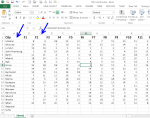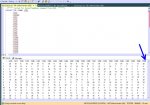cricketbird
Registered User.
- Local time
- Today, 03:39
- Joined
- Jun 17, 2013
- Messages
- 124
I would like to import (using an append query) data in the following format:
Sample Name Carbon Nitrogen Oxygen Hydrogen
Sample 123 10 20 30 40
Sample 234 15 54 25 60
to a table in my database with the following columns:
RecordID (autonumber primary key)
SampleID (foreign key to table Samples)
AnalysisID (foreign key to table Elements)
AnalysisValue
I usually use query builder, but it doesn't seem able to "flatten" the data in this way.
Can SQL handle this? Or can anyone think of a different approach than using queries?
End result: With the above example data, I want generate the following records to append:
RecordID Sample ID AnalysisID AnalysisValue
1 123 1 10
2 123 2 20
3 123 3 30
4 123 4 40
5 234 1 15
6 234 2 54
7 234 3 25
8 234 4 60
Thanks,
CB
Sample Name Carbon Nitrogen Oxygen Hydrogen
Sample 123 10 20 30 40
Sample 234 15 54 25 60
to a table in my database with the following columns:
RecordID (autonumber primary key)
SampleID (foreign key to table Samples)
AnalysisID (foreign key to table Elements)
AnalysisValue
I usually use query builder, but it doesn't seem able to "flatten" the data in this way.
Can SQL handle this? Or can anyone think of a different approach than using queries?
End result: With the above example data, I want generate the following records to append:
RecordID Sample ID AnalysisID AnalysisValue
1 123 1 10
2 123 2 20
3 123 3 30
4 123 4 40
5 234 1 15
6 234 2 54
7 234 3 25
8 234 4 60
Thanks,
CB




